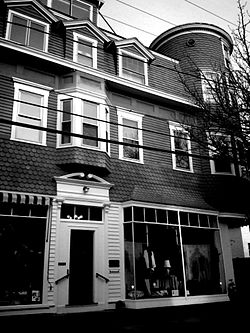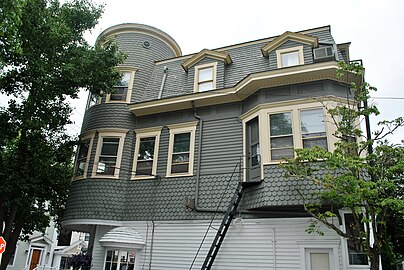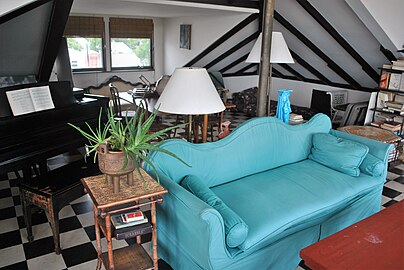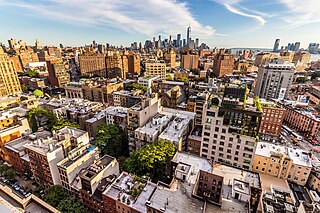
Greenwich Village, or simply the Village, is a neighborhood on the west side of Lower Manhattan in New York City, bounded by 14th Street to the north, Broadway to the east, Houston Street to the south, and the Hudson River to the west. Greenwich Village also contains several subsections, including the West Village west of Seventh Avenue and the Meatpacking District in the northwest corner of Greenwich Village.

Mystic is a village and census-designated place (CDP) in Groton and Stonington, Connecticut.

North Stonington is a town in New London County, Connecticut which was split off from Stonington in 1724. The town is part of the Southeastern Connecticut Planning Region. The population was 5,149 at the 2020 census.

James Ingram Merrill was an American poet. He was awarded the Pulitzer Prize for poetry in 1977 for Divine Comedies. His poetry falls into two distinct bodies of work: the polished and formalist lyric poetry of his early career, and the epic narrative of occult communication with spirits and angels, titled The Changing Light at Sandover, which dominated his later career. Although most of his published work was poetry, he also wrote essays, fiction, and plays.
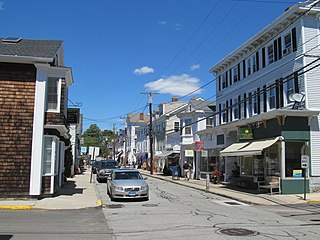
Stonington is a town located in New London County, Connecticut. The municipal limits of the town include the borough of Stonington, the villages of Pawcatuck, Lords Point, and Wequetequock, and the eastern halves of the villages of Mystic and Old Mystic. Stonington is part of the Southeastern Connecticut Planning Region. The population of the town was 18,335 at the 2020 census.
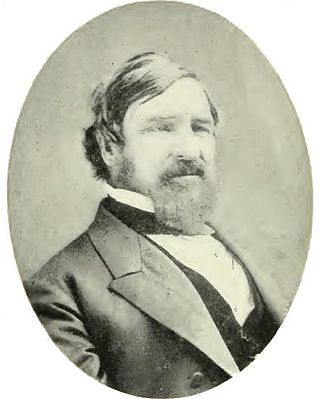
Nathaniel Brown Palmer was an American seal hunter, explorer, sailing captain, and ship designer. He gave his name to Palmer Land, Antarctica, which he explored in 1820 on his sloop Hero. He was born in Stonington, Connecticut, and was a descendant of Walter Palmer, one of the town's founders.

David Noyes Jackson was the life partner of poet James Merrill (1926–1995).
Jeffrey Skinner is an American poet, writer, playwright, and emeritus professor in the Department of English at the University of Louisville.
J. D. "Sandy" McClatchy was an American poet, opera librettist and literary critic. He was editor of the Yale Review and president of The American Academy of Arts and Letters.
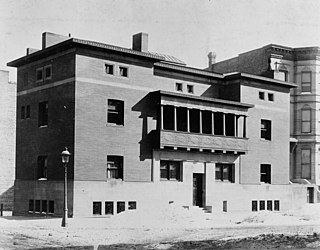
The James Charnley Residence, also known as the Charnley-Persky House, is a historic house museum at 1365 North Astor Street in the near northside Gold Coast neighborhood of Chicago, Illinois. Designed in 1891 and completed in 1892, it is one of the few surviving residential works of Adler & Sullivan.

The Capt. Nathaniel B. Palmer House is a historic house museum in Stonington, Connecticut, built in 1852–54. The house is a transitional style between the Greek revival and the Victorian Italianate. It was built for Nathaniel Brown Palmer (1799–1877), who was a seal hunter, a pioneering Antarctic explorer, and a major designer of clipper ships. Threatened with demolition, it was acquired by the Stonington Historical Society in 1995, which operates it as a museum devoted to Palmer. The house was declared a National Historic Landmark in 1996.
Sarah Gorham is an American poet, essayist, and publisher residing in Prospect, Kentucky.
Daniel J. Hall is an American poet.
Theodore "Ted" Deppe is an American poet and professor, author of books of poetry. His most well-known collection is Orpheus on the Red Line, and he has had his poems published in many literary journals and magazines including The Kenyon Review, Harper’s Magazine, Poetry, The Southern Review, Ploughshares, and Poetry Ireland Review. He was the Director of the Stonecoast MFA Program in Creative Writing’s Stonecoast in Ireland program.
Leslie McGrath was an American poet, editor, and educator. Critic Grace Cavalieri called McGrath “an oral historian of the alienated." She authored the poetry collection Feminists Are Passing from Our Lives ; Out From the Pleiades: a picaresque novella in verse, and Opulent Hunger, Opulent Rage, a finalist for the 2010 Connecticut Book Award for Poetry;. She received the Pablo Neruda Prize for Poetry in 2004, and taught at Central Connecticut State University from 2009 - 2019. She published three chapbooks: By the Windpipe ; the satiric novella in verse, Out From the Pleiades ; andToward Anguish, which won the 2007 Philbrick Poetry Award. Her most recent publication is a full-length collection of poetry Feminists Are Passing from Our Lives. McGrath co-edited Reetika Vazirani's posthumous poetry collection, Radha Says: Last

The Fraser Mansion is a building at 1701 20th Street NW, at the intersection of Connecticut Avenue, 20th Street, and R Street in the Dupont Circle neighborhood of Washington, D.C. constructed in 1890 to be the George S. Fraser mansion, it served as his private residence for five years, a restaurant, a boarding house, the home of the new Founding Church of Scientology, and—currently—the location of Scientology's National Affairs office.

The Amos Palmer House; is a historic Georgian style home located on Main Street in Stonington, Connecticut. It was built by Captain Amos Palmer in 1787 to replace his former home on the lot which burned after a neighbors' barn caught fire.

Stonington is a borough and the town center of Stonington, Connecticut, referred to by locals as "The Borough". The population was 976 at the 2020 United States Census, up from 929 in 2010.
Eryn Green is an American poet who in 2013, while a graduate student at the University of Denver, won the Yale Series of Younger Poets Competition. His collection Eruv was published by Yale University Press in 2014. His second collection of poetry, Beit, was awarded the 2019 Editor’s Choice from New Issues, and will be published in 2020.

Stonington Cemetery is a historic cemetery at North Main Street and United States Route 1 in Stonington, Connecticut. Established as a family cemetery about 1754, it was the first formally incorporated cemetery in New London County, with the incorporation of its association occurring in 1849. Its layout is reflective of changing trends in cemetery organization, from colonial practices to those of the 20th century. It was listed on the National Register of Historic Places in 2018.
